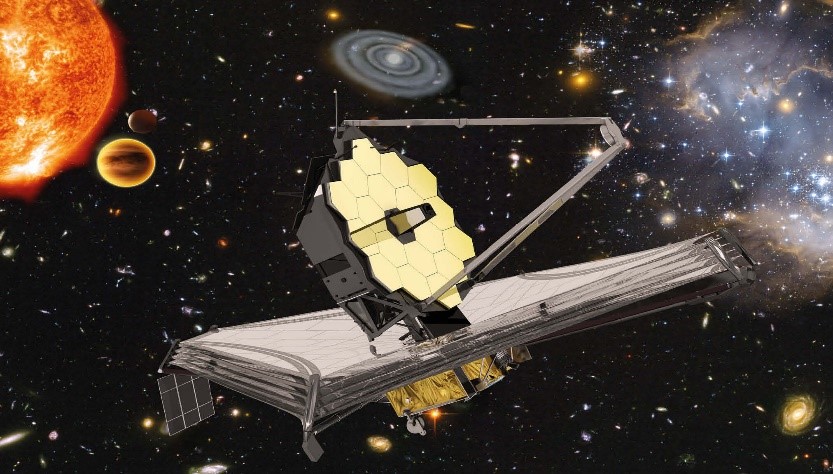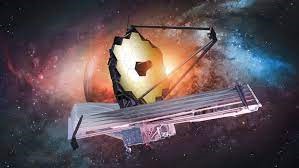Introduction to JWST and Its Significance
The James Webb Space Telescope (sometimes called JWST or Webb) will be a large infrared telescope with a 6.5-meter primary mirror. The telescope will be launched on an Ariane 5 rocket from French Guiana in 2021.
The Webb telescope will be the premier observatory of the next decade, serving thousands of astronomers worldwide. It will study every phase in the history of our Universe, ranging from the first luminous glows after the Big Bang, to the formation of solar systems capable of supporting life on planets like Earth, to the evolution of our own Solar System.

Figure.1 Introduction to JWST and Its Significance
Introduction to JWST and Its Significance is shown in Figure 1. The Webb telescope was formerly known as the "Next Generation Space Telescope" (NGST); it was renamed in September 2002 after a former NASA administrator, James Webb.
Webb is an international collaboration between NASA, ESA (the European Space Agency), and the Canadian Space Agency (CSA). NASA's Goddard Space Flight Center in Greenbelt, Maryland, is managing the development effort. The main industrial partner is Northrop Grumman; the Space Telescope Science Institute will operate Webb after launch.
Several innovative technologies have been developed for Webb. These include a primary mirror made of 18 separate segments that unfold and adjust to shape after launch. The mirrors are made of ultra-lightweight beryllium. Webb's biggest feature is a tennis court sized five-layer sunshield that attenuates heat from the Sun more than a million times. The telescope’s four instruments - cameras and spectrometers - have detectors that are able to record extremely faint signals. One instrument (NIRSpec) has programmable microshutters, which enable observation up to 100 objects simultaneously. Webb also has a cryocooler for cooling the mid-infrared detectors of another instrument (MIRI) to a very cold 7 kelvins (minus 447 Fahrenheit) so they can work.[1]
Unveiling the JWST:
The James Webb Space Telescope, often referred to as Webb, is a collaborative project involving NASA, the European Space Agency (ESA), and the Canadian Space Agency (CSA). Its construction and testing have taken years of meticulous work, bringing together the expertise of scientists, engineers, and researchers from around the world.
The JWST's Purpose and Goals:
At its core, the JWST is designed to answer some of the most profound questions in astronomy and astrophysics. It aims to capture images and data from the distant corners of the universe, providing insights into the early stages of cosmic evolution, the formation of galaxies, stars, and planetary systems, and the characteristics of exoplanets.
Beyond the Visible Spectrum:
One of the JWST's key features is its ability to observe in the infrared portion of the electromagnetic spectrum. Unlike the Hubble Space Telescope, which primarily captures visible and ultraviolet light, the JWST's instruments are optimized for detecting infrared radiation. This capability allows the telescope to penetrate through cosmic dust clouds, revealing hidden phenomena that were previously inaccessible to other observatories.
Pushing the Boundaries:
The JWST is set to push the boundaries of observational astronomy to new frontiers. Its advanced instruments will enable scientists to peer back in time, studying the universe as it existed shortly after the Big Bang. By detecting the faint glow of distant galaxies, the JWST will provide insights into the formation of the first stars and galaxies and shed light on the universe's infancy.
Revolutionizing Exoplanet Studies:
Another major aspect of the JWST's mission is the study of exoplanets—planets located beyond our solar system. With its infrared capabilities, the telescope will be able to analyze the atmospheres of exoplanets, searching for signs of habitability and even potential biosignatures. This opens up a realm of possibilities in the search for extraterrestrial life.
Launch and Deployment:
The JWST is set to be launched aboard an Ariane 5 rocket from French Guiana. Once in space, it will travel to the second Lagrange point (L2), a stable position in the Earth-Sun system that allows the telescope to have an unobstructed view of the universe. Its deployment process is a marvel of engineering, involving the unfolding of its sunshield, the precise positioning of its segmented mirror, and the activation of its instruments.
In essence, the James Webb Space Telescope represents a monumental achievement in human innovation and a testament to our unending curiosity about the cosmos. Its ability to observe the universe in ways previously thought impossible holds the promise of unveiling new mysteries and rewriting the textbooks of astronomy. In the subsequent parts of this blog series, we'll delve deeper into the engineering marvels, scientific instruments, launch logistics, and anticipated discoveries that make the JWST a true marvel of modern space exploration.
References:
- https://www.nasa.gov/mission_pages/webb/about/index.html
Cite this article:
Gokula Nandhini K (2023), James Webb Space Telescope (JWST), AnaTechmaz, pp.1





